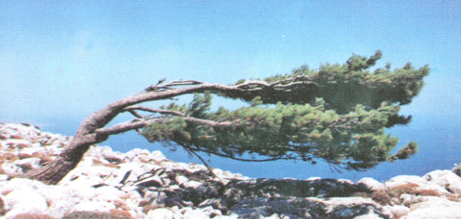In June 1923, not being able to excavate in war-torn Anatolia, the Italian School Director, Alessandro della Seta, took with him two of his students, Gilbert Bagnani and Giulio Jacopich, to explore around the remote island of Karpathos, one of the Dodekanese islands which had been seized by Italy from the Ottoman Empire in 1912. Della Seta’s brief notices of heir explorations in the Annuario and Bollettino d’Arte were cursory, and Bagnani’s ten page report, which I found in the Italian School archives, was never published. So far, no photographs of this journey have been found either in Ontario, Athens or in the material handed over by the Italians to the Greeks on Rhodes in 1947, although Bagnani was the photographer for the expedition.
Although Karpathos lacked much arable land, it did have naturally sheltered harbours especially along the west coast, and its forests of pine trees could have provided timber and pitch for ships, but its greatest resource was its people. Homer’s epithet for Karpathos was windy, and still today its relentless strong north winds leave trees permanently bent southward under their force. The local sailors, however, gained a reputation for being able to navigate northward against the summer meltemi. In the early fifth century CE, a fleet of state-owned Karpathian ships regularly brought grain from Alexandria in Egypt to the new imperial capital of Constantinople. In the 10th century Karpathians contributed to the development of galley ships and, when Nikephoros Phokas was planning his naval attack to expel the Saracens from Crete in 960 CE, he relied on Karpathian sailors to pilot his ships. When the Venetian monk Buondelmonti visited Scarpanto c. 1420, he observed that the inhabitants were stained black from pitch, the sap from pine trees which was used to make wooden ships water-proof. So the Karpathiotes had a documented history as sea-farers and ship-builders spanning at least a thousand years. Indeed, the traditional Karpathian house (one large room whose back half is elevated above the storage area and whose lower front half is used as living space surrounded by rows of dishes mounted on the wooden walls) could conceivably derive from captain’s cabins on ships, circumstantial evidence for the unique seafaring heritage of the island.

After a crossing so rough that Gilbert relished describing it, on June 12 the three Italians landed at Pigadhia, the largest harbour on the east side of Karpathos. They traveled around the island on mules, three used for riding and two for their baggage. Crossing over the mountain range from the east to the west coast, Gilbert admired the spectacular scenery (“extraordinarily picturesque”) of both coasts simultaneously before descending to Arkasa, ancient Arkaseia.
The harbour at Arkasa is dominated by an enormous promontory attached by a shallow neck of land to the beaches on either side of it. On this neck near the small church of Agia Sophia a round threshing floor had recently been constructed on top of the remains of an ancient church and its cemetery. A little clearing soon revealed the extensive and colourful mosaic floors “extraordinarily rich in geometric patterns” of the atrium and narthex of an early Christian basilica dedicated to Agia Anastasia. To their surprise, only a few centimeters below these mosaic floors they discovered the well-preserved mosaic floors of an earlier basilica, perhaps destroyed by the same devastating earthquake that struck Kos c. 550 CE. The early Christians on Karpathos and the rest of the Dodecanese were so numerous and prosperous in the fourth and fifth centuries that they built at least thirty-five basilicas around Karpathos alone, mostly along the shores, especially in ports.
Leaving Jacopich behind to supervise the clearing of the mosaics, Gilbert and della Seta set out to explore the rest of the island. They rode northward along the coast for another eight hours over “a difficult and in certain points ruined mule path” to the next natural harbour at Leukos, where they discovered the extensive remains of a lost city. From there Gilbert and della Seta rode inland and upward for seven hours to reach the mountain-top village of Elymbos. Here, remarkably, the town was so isolated that its inhabitants still spoke a distinctive form of Greek related to ancient Dorian. Their system of matrilineal inheritance through the female line seemed also to preserve a tradition of the ancient Karpathiotes, possibly due to the absence of their men folk away for prolonged periods at sea sometimes never to return. Women performed many tasks usually done by men such as managing the shops and animals, though now the men were out on the hills as farmers and shepherds.
From there, Bagnani and della Seta rode down to the fortified promontory of ancient Greek Brykous, subsequently occupied by early Byzantines. They then recrossed the island to the small port of Diafani on the east coast of Karpathos, from where they sailed up to the now deserted island of Saria. Here at Palatia on both sides of a small cove they explored some unusual rectangular barrel-vaulted structures and domed square ones, one still with a partly preserved red-painted inscription. Although believed to be Byzantine in date, nothing quite like this enigmatic assemblage of structures has been found anywhere else in the Aegean.
After they sailed back south to Pigadhia, della Seta set sail for a brief circuit of the Dodecanese while Gilbert returned to Arkasa to excavate up on top of the promontory overlooking the basilicas by the shore. He discovered some Roman houses near the remains of a small Byzantine church and sketched some of the sections of walls on the promontory. He also sketched the walls and the beach harbour at Phoiniki north of the promontory before sailing back to Athens.

